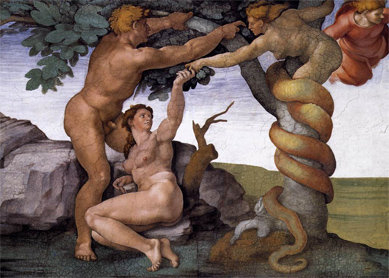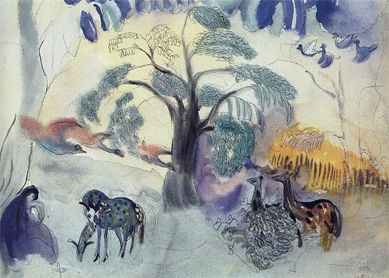Biblical Eden’s rich and complex fabric of interwoven themes and images, which reflects the Bible’s broader cultural context, grips the imagination with fundamental questions of time, narrative, and human experience.
What does the Eden narrative signify?
The Sumerian word edin, “steppe, plain,” and the Sumerian Dilmun myth suggest to some that biblical Eden was a place in southern Mesopotamia. The Mesopotamian Atrahasis epic opens with the gods digging the irrigation canals of the steppe and plain, including the Tigris and Euphrates rivers, before passing the work on to humans, whom they created for this purpose. Similarly, in Genesis the garden is planted in Eden by the Lord, who placed the first man in it to work and to keep it. Ezekiel calls Eden the “garden of God” (Ezek 28:13; also Isa 51:3), and its subterranean water source in Genesis reflects other ancient Near Eastern descriptions of the divine abode. The garden oasis was an important symbol of life in the arid climate of the ancient Near East (see Joel 2:3), and its association with the temple, the “house” of the Lord, presents the image of Eden as a model for the human encounter with divinity (see Ezek 47:1-12; Zech 14:8).
Life, death, knowledge, motive, power, identity, and sexuality are among the principal ideas and images in this biblical story of origins. Christian tradition understands the Eden story as the basis for the doctrine of “original sin.” (Though Judaism sees no notion of original sin in it.) Other biblical texts suggest that “knowledge of good and evil” can signify moral, sexual, comprehensive, or mature knowledge. Some believe the story commemorates a major cultural development: the transition to agriculture. The philosopher Immanuel Kant saw in the narrative human development from animal instinct to free choice, reason, and their consequences. Others find a more existential description of human alienation from God, the separation from our initial encounter with the world as a value-free state of consciousness.
Eden is called “paradise,” a word derived from the Persian pardes (a walled park or garden), which found its way into Greek as paradeisos; this, in turn, was used by the Greek translators of Genesis to translate the Hebrew word gan, “garden.” Rabbinic interpreters used PARDES as an acronym for the four interpretive levels (corresponding to each of the four consonants, p, r, d, and s) of biblical literature, from the plain sense to the mystical—the deepest level of meaning, which reestablishes direct contact with the divine.
Who is the talking serpent?
The enigmatic, secret-revealing serpent and its relationship to the Lord reflect a diverse and ambiguous array of traditions associated with life, death, and the disclosure of divine secrets. Many students of the Eden narrative are familiar with the Gilgamesh epic’s tale of a serpent snatching the plant of eternal life from Gilgamesh. The serpent in Gen 3, who is ambiguously called “crafty” or “clever” (also a play on the Hebrew term for nakedness), reveals the Lord’s true, but hidden, motive for prohibiting consumption from the tree of the knowledge of good and evil. In another Mesopotamian myth, the primal human Adapa misses the opportunity for eternal life when Enki, god of wisdom, tricks him out of eating the food and water of eternal life offered by the god Anu. Likewise, in the Mesopotamian flood narrative, Enki reveals the secret plan of the gods to humans, angering the high god Enlil.
The Hebrew Bible portrays serpents and serpentine creatures both positively and negatively (see, for example, Num 21:6-9). Flying serpents represent danger (Isa 14:29, Isa 30:6), but they are also associated with the heavenly court (Isa 6:2-7). Similarly, the divine being ha-Satan, “the adversary,” in Job 1-2 and Zech 3:1-2 is a member of the heavenly court who participates with the Lord in the administration of disaster and judgment (see Num 22:22; 1Chr 21:1). In later traditions, the serpentine “dragon,” associated with the sea and precosmic chaos (see Ps 74:13-14; Isa 27:1-2; Job 3:8) and Eve’s claim of having been deceived (Gen 3:13) combine to connect the serpent of Eden with Satan (Rev 12:9-10, Rev 20:2, Rev 10; John 8:44; 2Cor 11:3).
Bibliography
- Callender, Dexter. Adam in Myth and History: Ancient Israelite Perspectives on the Primal Human. Winona Lake: Eisenbrauns, 2000.
- Wallace, Howard. The Eden Narrative. Atlanta: Scholars Press, 1995.
- Charlesworth, James H. The Good and Evil Serpent: How a Universal Symbol Became Christianized. New Haven: Yale University Press, 2010.
- Delumeau, J., and M. O’Connell. The History of Paradise: The Garden of Eden in Myth and Tradition. New York: Continuum, 1995.
- Wilensky-Lanford, Brook. Paradise Lust: Searching for the Garden of Eden. New York: Grove Press, 2011.
- Morris, Paul, and D. Sawyer. A Walk in the Garden: Biblical, Iconographical and Literary Images of Eden. Sheffield: Sheffield Academic Press, 1992.





